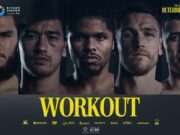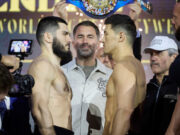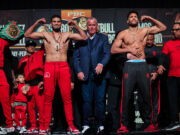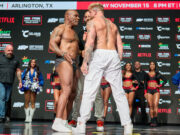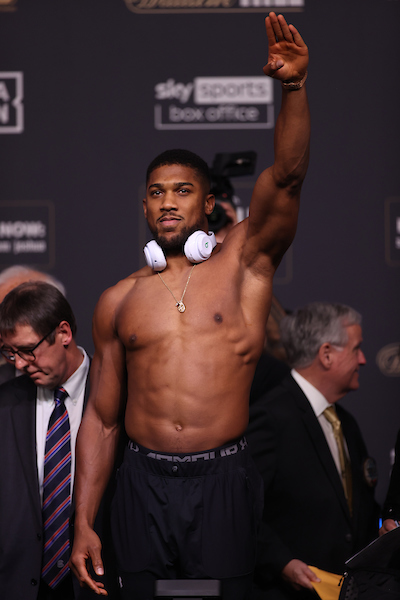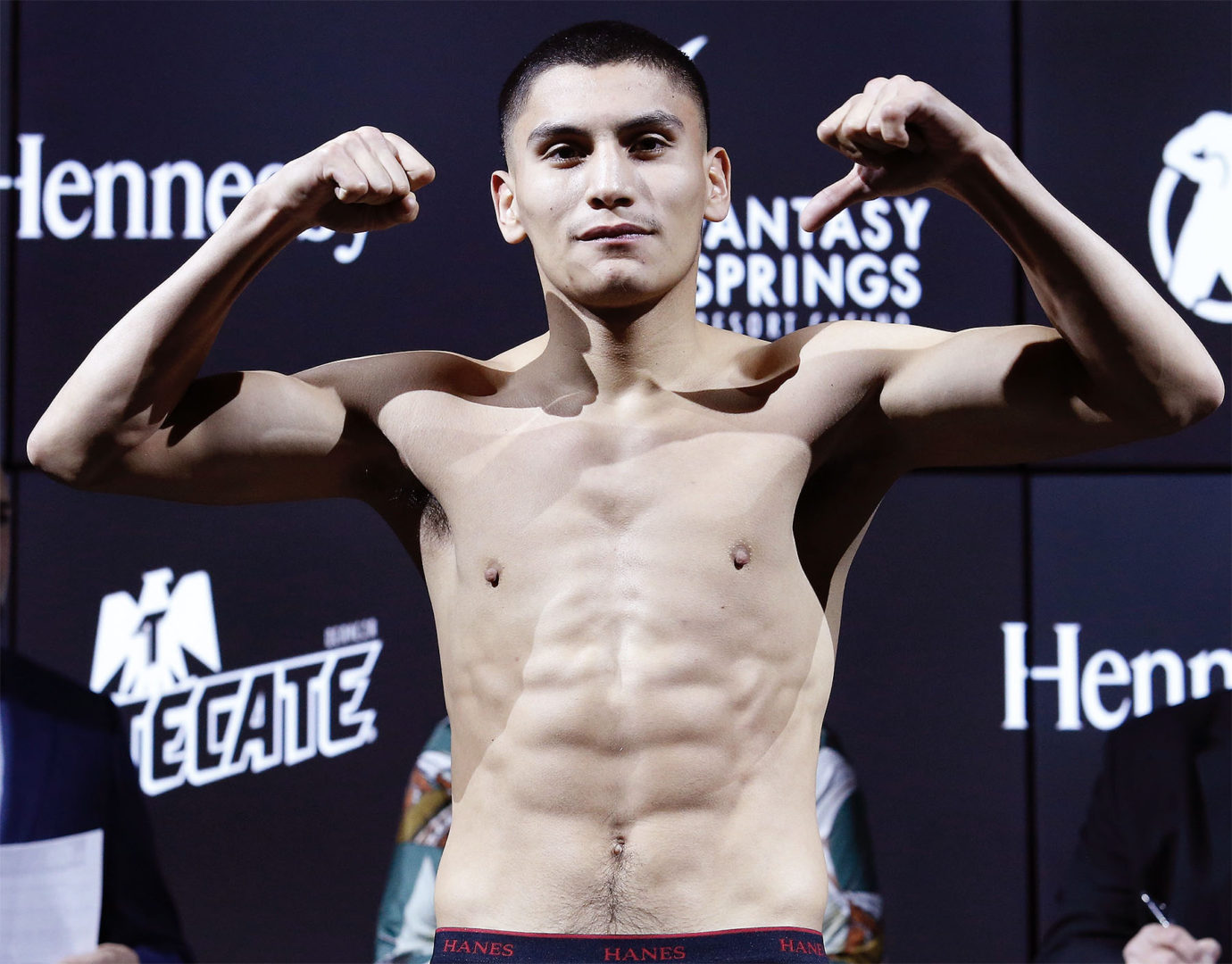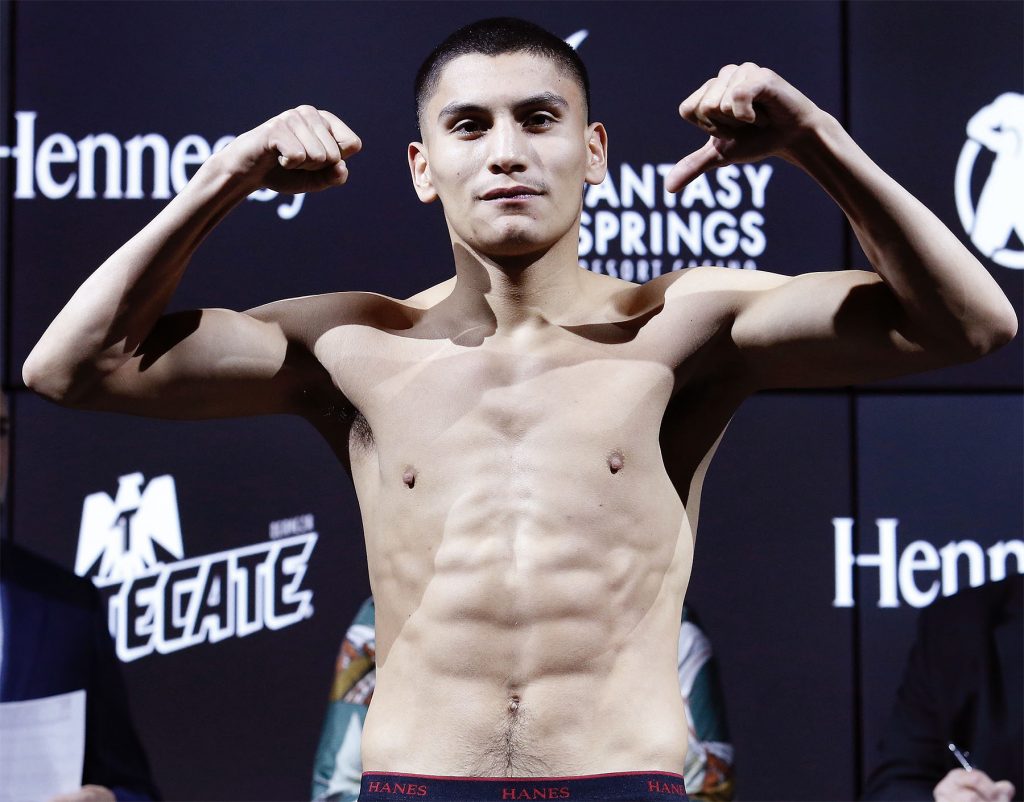
By Bart Barry –
Friday DAZN returned to boxing broadcasting with a good mainevent from Indio, Calif., in which undefeated Texas welterweight Vergil Ortiz manhandled Colombian veteran Samuel Vargas in an empty casino ballroom. Ortiz threw every punch correctly and concussively and wore Vargas away till the end of round 7 brought a merciful technical stoppage.
Too early to say with Ortiz. He does everything right and well and says the right things, too, but questions galore remain about his handlers, his promoter and his trainer, and their aptitude for developing a young prospect like Ortiz. There’s a pink flag in there, as it were, about his weight, as well.
Ortiz turned pro four years ago as a junior welterweight and began campaigning round 147 a year ago without first winning a world title at his born-on weight. Much as Golden Boy Promotions needs promising prospects and many as the world titles are in the world it’s a touch concerning Ortiz outgrew junior welter before his promoter got him a title shot. And while many prospects have been funneled to Robert Garcia’s Oxnard these last 10 years, since Garcia steered Brandon Rios to an unlikely championship and nearly got Antonio Margarito blinded by Manny Pacquiao, there are a few questions about Garcia’s versatility as a trainer and teacher.
Samuel Vargas was an interesting choice of opponent for Friday’s match and DAZN’s return to boxing. Vargas is a welterweight ratings board unto himself. How you did against Vargas sets your status: Errol Spence (KO 4), Danny Garcia (KO 7, 2:17), Ortiz (KO 7, 2:58), Amir Khan (UD 12), Luis Collazo (SD 10): Collazo gets decisioned by Khan who gets stiffened by Ortiz who gets decisioned narrowly by Garcia who gets decisioned widely by Spence. Would that all things were so symmetrical.
Vargas showed more than merely heart in Indio. He showed veteran savvy when hurt; once he realized he couldn’t attrite Ortiz he retreated to the ropes and boxed pretty effectively, taking away Ortiz’s firstchoice weaponry and stinging him with accurate if anemic counters; he made Ortiz make decisions Ortiz had yet to make in his prizefighting career but will have to make whenever his promoter tries to make real money with him.
Vargas was a low-intermediate challenge for Ortiz but unfortunately the best sort of test Ortiz will see before being the b-side against bigger promoters’ titlists. PBC owns every welterweight a-side but one, and Ortiz sure ain’t ready for Bud Crawford. Thus the pink flag allusion above. There’s no substitute for the experience of a 12-round title fight, for exhausting oneself in 36 minutes of combat with a man who expects to beat you – either because it’s his belt and you’re the usurper, or because the title is vacant and he resents your quick ascent – but Ortiz isn’t going to have any of those at welterweight, and it’s unfortunate he didn’t have any at 140 first. You have to get seven deep in The Ring’s current 147-pound ratings before you consider making Ortiz a favorite, and even then it’s not much of a consideration.
Who, then, will Ortiz perfect his craft against in the weird silence of a pandemic? Don’t answer that. Let’s treat that weird silence instead.
There was an interesting moment in between one of the rounds of Ortiz-Vargas on Friday. DAZN showed an instant replay without commentary, ostensibly to allow viewers to hear the concussiveness of Ortiz’s punches, but what you heard nearly as much were DAZN’s commentators yelling about the punches in realtime. I don’t think I’ve ever heard commentators so clearly in an instant replay. Then there was veteran referee Jack Reiss’s trip to Ortiz’s corner to explain his reason for admonishing Ortiz to stop spinning Vargas a round after DAZN’s Sergio Mora talked loudly about how much he disagreed with his own misinterpretation of Reiss’s officiousness.
Lots of strange new ingredients, there. The referee hearing so clearly what was being broadcasted about his performance, the twoman commentary crew – seated 20 feet apart and invariably yelling to one another without realizing it – seeing the referee influenced by its commentary, the fighters’ conversations with one another and the referee being casually audible, and the absence of thousands of their fellow men communicating in yells and whispers and cheers and beer orders reducing the number of words the twoman crew spoke during the action. It was a more intimate spectacle, a purist’s view, but nothing to attract casual fans, who delight in celebrity and sadism much more than craft or tactical nuance.
Variables affecting variables at variable rates – the quintessence of selforganization. The promoters and networks, who play a centralizing role, surely don’t enjoy all these new variables (except for Bob Arum who’s old enough to find it amusing), but the fighters don’t seem to mind it too much. They’d rather have what initial adrenaline a crowd supplies, but their ability to summon adrenaline from nearly any source is why they’re professional fighters; so long as paychecks clear and bank accounts stabilize prizefighters mightn’t mind the intimacy of their new arrangement.
Viewers are certainly privy to more than we were before. Again, the cameras and commentators and promoters and commissioners and pressrow media, all, were existentially invested in having a monopoly on the information given aficionados. In most cases these monopolies were naturally erected; Max and Jim and Larry were able to tell you things you didn’t know because they had a truckful of guys with headsets hearing all the things you couldn’t hear, and their commentary was essential in marketing to you a product intended to grow subscribers – just like Sergio’s commentary and Tim and Dre’s commentary and Paulie and Al’s commentary.
But as subscribers go wanting and advertisers go with them, we draw closer to a day, perhaps, when aficionados can have all we’ve ever wanted: a commentary-free audio track. For an educated viewer, after all, there’s never been anything so poetic as the sounds of punches, in their sundry rhythms and rhymes, and how blissful might it be to listen finally without impediment?
Bart Barry can be reached via Twitter @bartbarry












